VOL. 28, #2, Summer 2010
Gem Market Economics, Finding a Gem, Cool Gadgets, Notable Quotes, Auction Reports, Gem Movies, Heist News, In The News
- Home
- Newsletter
- VOL. 28, #2, Summer 2010
Gem Market Economics, Finding a Gem, Cool Gadgets, Notable Quotes, Auction Reports, Gem Movies, Heist News, In The News
Finding A Gem
by Sara Marma
Bespoke
Spring 2010
Bespoke is an upscale California magazine. Recently, National Gemstone was interviewed for the piece. - EDITOR
This gem held a unique status, being highly regarded by the Maharajahs of the great Mughal period, as well as Europe's rulers and social elite.
Picture a gem so strikingly blue that a single glimpse evokes the tranquility of sailing through crystal clear ocean waters. Now imagine an orange-red sparkler so seductive in its fiery intensity that you can't help but believe it was handcrafted especially for you.
Herein lies the allure of colored gems a vast assortment of precious and semi-precious stones that naturally form in an array of colors so breathtakingly beautiful you've only experienced them in dreams. While casual gem collectors and connoisseurs alike can appreciate the "Big Four" diamonds, rubies, emeralds and sapphires few realize the full spectrum of dazzling alternatives available.
Lesser-known semi-precious stones like tsavorite, aquamarine, fancy sapphire, tanzanite, garnet and tourmaline offer timeless beauty and distinctive personality while embodying the prestige and mysticism of more traditionally coveted stones. In fact, certain varieties of tourmaline, a stone that appears naturally in more colors and hues than any other gemstone, can be rarer than emeralds or rubies.
Supply and Demand
Unlike diamond mines, gemstone mines tend to be very small and last only for short periods of time, making gem deposits from any single geographical location a valuable commodity.
When a source becomes depleted, mining companies must move quickly to uncover the next and meet the demand for a particular stone.
"What we're seeing is that when the public becomes more aware [of a particular gem], demand increases and supply may or may not be able to keep pace, especially if there isn't a new discovery somewhere," says Antoinette Matlins, an internationally respected gemologist and author of "Colored Gemstones: The Antoinette Matlins Buying Guide." This, of course, has the potential to dramatically influence a stone's value. As a result, the number of recognized gemstones fluctuates from time to time, as does the number of gemstones classified as "precious" and "semi-precious" stones.
Generally speaking, colored stones are evaluated according to the same "4 C's" (Color, Cut, Carat and Clarity) that deter-Mine a diamond's value, but on a much more flexible scale to account for subtle differences in physical composition, which reflects a stone's origin.
In some cases, a stone's origin is the single most important factor in assessing its value. Consider the Brazilian Paraiba tourmaline, which exists in "Windex blue" and fluorescent green varieties. First discovered in 1990, these stones are nearly non-existent today and sell for more than the highly prized Kashmir sapphire. Although similar material has been discovered in Nigeria and Mozambique, nothing has achieved the status of the Brazilian variety.
Other factors that influence a gemstone's value include evenness, transparence and, of course, color. The less interference from inclusions and the more clear the color, the better quality a stone; likewise, the brighter and more vivid a stone's color, the greater its value. A rich, deep-green chrome tourmaline, for instance, will fetch more per carat than a salmon-colored tourmaline of comparable quality.
What's In
One must never underestimate the influence of fashion either. Although history proves that true gemstone popularity is achieved over a span of centuries as is the case with the Big Four trends can certainly influence the popularity of any given stone in any given time period.
"To say that one color is more popular than another today may not be as true for yesterday or tomorrow," says Ken Scarratt, managing director at Gemological Institute of America (GIA), the world's foremost authority on colored stones. "Ten years ago, pink stones were not particularly valuable, but five or six years ago pink became the in' color in fashion. During that era, you saw the popularity of pink stones shoot right up and along with that, the prices of them." Similarly, when tanzanite was first unveiled in the marketplace, many saw it as an affordable sapphire imitation, while others appreciated its distinctive qualities. At the time, an impressive tanzanite could be acquired at a very reasonable price; Today its popularity has driven the price upward.
"With the staples, brighter, more vivid colors tend to be the most sought after; the colors of the trendy pieces seem to change much more between all shades of the color spectrum," says Gregg Helfer, a Chicago-based private jeweler who has seen a recent shift in preference toward darker stones like smokey topaz and citrine.
Another trend that appears to be gaining momentum is the preference for colored stone engagement rings. According to Robert Genis, president of National Gemstone, the number of colored gemstone wedding rings is on a 10-year steady rise. Famous brides like Jennifer Lopez, Princess Diana and Susan Sarandon are among the ranks of those who have foregone conventionality in favor of self-expression.
"Increasingly, there are many independent jewelers and fabulous designers who are using a much wider spectrum of gemstones in jewelry, and it's exciting," says Matlins.
Perfect Match
Finding the perfect gem in a sea of seductive stones can be overwhelming. Matlins, who performs gem and jewelry searches on behalf of discerning clients worldwide, asks, first and foremost, "Why?" If it's a particular color her client desires, she'll advise the client about the range of options. If the goal is to mark a milestone with only the most precious of gems, she takes an entirely different approach.
"So many gems are immersed in mystique and loyalty, and precious associations," says Matlins.
"If you have a milestone in your life, people want to have one of the rarest of the rarest; then there are people who simply want something that makes them feel beautiful." Others prefer certain colors for their symbolism.
Red, for example, represents passion and love, while blue is associated with loyalty and intelligence. The color green is said to convey growth and harmony.
Another way to express individuality is by choosing lesser-known, yet equally extraordi-Nary, gems. Matlins' favorites include mandarin and tsavorite garnets, and various stones from the tourmaline and spinel families specifically because they are rarely color- or clarity-enhanced. Iolite and peridot also earn this distinction, which appeals to gem collectors on another level.
Because 95 to 99 percent of all colored gemstones are "treated," or altered beyond cutting and polishing, in some manner, the all-natural gems are the rarest of all and can make an excellent investment.
Genis, who specializes in the sale of highend gemstones to collectors and investors, advises that gemstone investments can be complicated and are best suited for the sophisticated individual with a substantial portfolio.
Those who simply enjoy a spectacular colored stone might also consider the demantoid garnet, an opal with "color play" or the chrysoberyl cat's-eye.
Genis favors the ruby look-alike, Burma spinel, as well as fancy sapphire, orange garnets from Namibia and Nigeria, and the brand-new red tourmaline, Rubellite, from Africa.
When buying a colored stone, it's important to realize that not everything is as it seems. That's why due diligence is essential. Before meeting with a prospective seller, any buyer should conduct her own research on the Internet and be prepared to ask a few key questions.
It is also crucial to obtain an American Gemological Laboratory (AGL) Colored Stone Grading Report for any stone under consideration and discuss it at length with a reputable independent source. The Federal Trade Commission requires that if a gemstone's treatment has a dramatic impact on pricing, durability or carriage required, it must be disclosed explicitly by the seller at the point of purchase.
In addition to its impact on the value of a gem, treatment can affect a stone's wearability. Garnet, for instance, is extremely durable and well suited for most jewelry, whereas tanzanite is less durable and should be given a protected setting in a ring.
"You need to know what you're buying," insists Scarratt. "It isn't always a question of value; it's a question also of how do you care for a stone that has been treated in some way."
Cool Gadgets
Luxury Bluetooth headsets
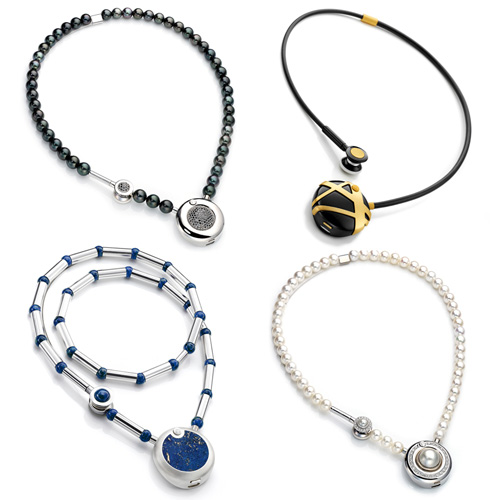
Novero has introduced five ultra-expensive Bluetooth headsets. The headsets are pavéd with gemstones and precious metals. All four devices differ in style and materials but have the same Bluetooth capabilities.
Three of the styles are for women. The Victoria Lapis features a blue stone dusted with gold pyrite, The Victoria Pearl necklace is handmade gold, while Victoria Stripes uses black silicone with brushed gold. The Victoria Wave sports a white and blue pendant and is for men. The Victor features a pendant that travels around the neck and clips onto a shirt or jacket. The price? $120,000.
Diamond-studded iPad unveiled
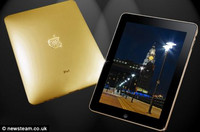
Stuart Hughes recently introduced a gold and diamond encrusted version of Apple's iPad. At a cost of almost $200,000, the new Gold edition is the latest in a long line of luxuriously modified mobiles and gadgets he has created.
A total of 53 diamonds have been embedded in the iPad's golden shell. People with slightly smaller budgets can still get a gold-plated iPad, minus the gemstones, for about $3000.
Notable Quotes
"Indians thought of butterflies as gemstones of the gods, tossed from the heavens to spread beauty."
Newsobserver
Staff
May 30, 2010
"Red spinel gemstones are reminiscent of Queen Elizabeth's Timur Ruby."
German jeweler Christian Hemmerle
New York Times
May 20, 2010
"The European Union enacted its own ban on Burmese gems, followed in 2008 by a tightening of the U.S. measure that effectively banned all Burmese ruby and jadeite imports regardless of where they were cut. As a result, more than 50 ruby mines closed down in Myanmar, while buying by foreign dealers reportedly fell by more than half in the latter part of 2008."
Russel Shor
Gems and Gemology
Winter 2009
Auction Reports
Sotheby's New York- May
The New York sale of Sotheby's Magnificent Jewels brought almost $35 million and was 91.7 percent sold by value. According to Lisa Hubbard, chairman of the international jewelry department, North and South America, commented, "It was a sophisticated sale for connoisseurs, defined by the extremely rare colored diamonds and colored gemstones that were offered for sale. Having traveled with the highlights around the world for the last two months, it's clear this is a global market, with buyers seeking top quality stones and special pieces wherever they are offered."
Here are the highlights:
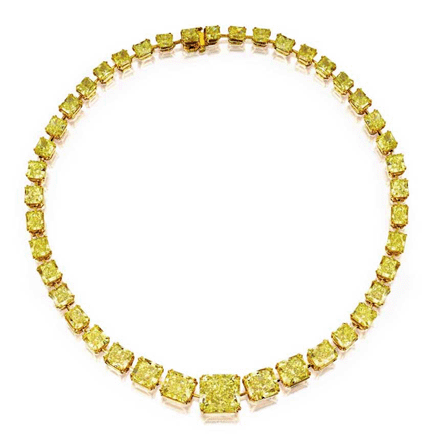
The top price was achieved by a fancy vivid yellow diamond necklace, which soared to $3,554,500. The matching 42 GIA Fancy Vivid Yellow Diamonds from a private collection totaled 100.17 carats. It is is believed to be the first necklace set entirely with fancy vivid yellow diamonds ever to have appeared at auction. It was purchased by a Chinese collector.
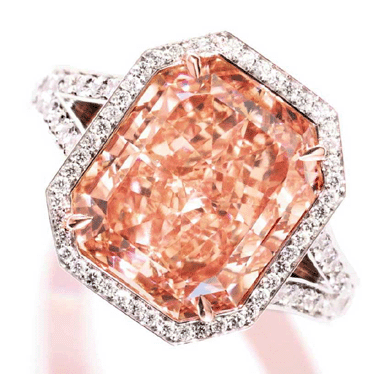
A radiant 7.67 fancy intense pinkish-orange diamond, internally flawless sold for $3,106,500, or $405,019 per carat. It is the largest flawless or internally flawless diamond of this pinkish-orange color graded by the GIA to date.
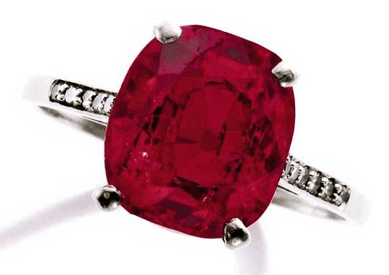
An 8.66 cushion-shaped Burmese ruby sold for $2,098,500 or $242,321 per carat after being chased by more than five bidders. The ruby was formerly owned by Isabella Stewart Gardner.
A collection of Kashmir sapphires weighing from 4.29 to 8.73 carats, brought a collective total of $2,854,000 and was led by a pair of 8-carat stones, which totaled $1,082,500.
An emerald and diamond bracelet, Tiffany & Co., circa 1925, set with almost 40 carats of matched Colombian emeralds, once in the collection of Annie-Laurie Aitken, was offered from a private collection and climbed to $650,500.
A round 9.25 carat D color, internally flawless, type IIa graded stone sold for $1,538,500.
Christie's Hong Kong-June
Christie's Hong Kong Sale realized over $60 million and was 89 percent sold by lot. The top lot of the sale was a magnificent, single-stranded, jadeite-beaded necklace, which sold to a private Asian buyer for $7,275,144.
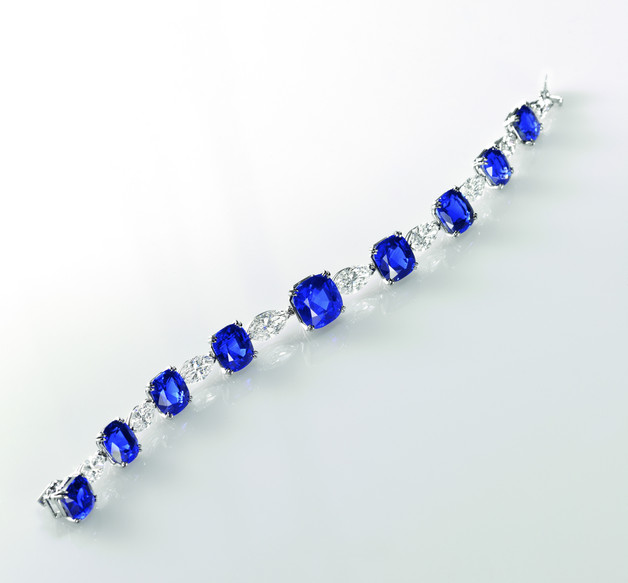
A 49.61 carat Kashmir sapphire and diamond bracelet, circa 1960, by Cartier, sold for $6,915,624. This item, according to Christie's, set a world auction record for a bracelet. The Kashmir sapphire bracelet, which sold for $6.9 million, had been sold by Christie's previously in 1988 for $902,000, which represents $1.7 million in today's currency.
Another Kashmir sapphire weighing 17.45 carats sold for $1,738,536.
A heart-shaped, fancy vivid blue, 5.01 carat, VS2, diamond sold for $935,000 per carat or $4,686,600. It was bought by a private Asian buyer. A pair of fancy, deep blue, heart-shaped diamonds weighing 2.48 carats and 2.03 carats and suspending a pair of 10.12 carat and 9.64 carat, pear-shaped diamonds sold for $4,398,984. A heart-shaped, 2.88 carat, fancy, deep blue diamond sold for $1,666,632 or $579,000 per carat.
Sotheby's Geneva-May
Sotheby's Magnificent Jewels sold a total $54 million in Geneva and the auction sold 87.9 percent by lot and 96.6 percent by value. A new record was reached for the sale of a fancy intense blue diamond.
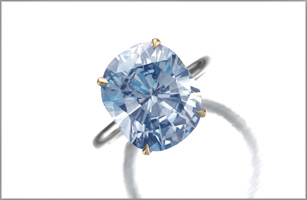
A cushion-shaped, 7.64 carat fancy intense blue diamond ring fetched $8 million, or $1.1 million per carat, from an anonymous buyer. The ring saw three potential buyers bidding before closing.
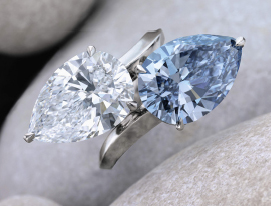
Another blue diamond was the 5.02 carat, fancy vivid blue sold. It went for $6.3 million diamond and was set with a 5.42 carat white diamond in a ring.
Red Diamond Goes Unsold at Sotheby's
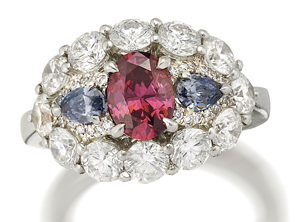
A red diamond from Rio Tinto's Argyle mine to be auctioned in Australia failed to sell when it went under the hammer at Sotheby's in Sydney. The piece was expected to go for between $700,000 and $1 million, but the bidding closed at just $490,000 after opening at $480,000. The diamond is oval-shaped, 0.82 carat, fancy purplish red, of SI1 clarity and set between a pair of brilliant, round-cut, fancy blue diamonds mounted in platinum. Given the rarity of these stones, this is amazing and may reflect the bad economy.
Gem Movies
JJ Abrams Diamond Heist Movie
Movie Moron
June 6, 2010
The Untold Story of the World's Biggest Diamond Heist is awesome. Now it's going to be told in the form of a major motion picture from inimitable producer JJ Abrams. Phil Alden Robinson has been tapped to write the thing, and there is a possibility he'll direct the project as well. He's previously handled directorial duties on the Ben Affleck vehicle Sum of All Fears, the Kevin Costner movie Field of Dreams and the first episode of television mega-hit Band of Brothers.
The gist of the story is this:
In February 2003, [Leonardo] Notarbartolo was arrested for heading a ring of Italian thieves. They were accused of breaking into a vault two floors beneath the Antwerp Diamond Center and making off with at least $100 million worth of loose diamonds, gold, jewelry, and other spoils. The vault was thought to be impenetrable. It was protected by 10 layers of security, including infrared heat detectors, Doppler radar, a magnetic field, a seismic sensor, and a lock with 100 million possible combinations. The robbery was called the heist of the century, and even now the police can't explain exactly how it was done.
Noel Clarke's New Diamond Film
4,3,2,1 Film Review
4321noelclarke
June 1st, 2010
4.3.2.1, is a sexy, gripping thriller following three days in the lives of four very different girls. Starring some of Britain and America's most exciting rising stars including Emma Roberts (Nancy Drew, Wild Child), Tamsin Egerton (St. Trinian's), Ophelia Lovibond (Nowhere Boy, London Boulevard) and Shanika Warren-Markland (Adulthood), the four intricately woven stories are about four best friends who become involved in a major diamond heist.
Whilst Jo (Emma Roberts) is chained down in a dead end supermarket job, her friends are all out on their own separate adventures: Cassandra (Tamsin Egerton) is jetting off to New York to meet her Internet boyfriend; Kerrys (Shanika Warren-Markland) is on a one woman crusade fighting for female liberation and Shannon (Ophelia Lovibond) is on a one way trip to meet her maker. But a chance encounter with some diamond thieves sends their separate worlds on a collision course with not only each other, but fate itself. These 4 girls are about to have 3 days they will never forget, spanning to 2 cities. That is
if they survive
What is refreshing about the film is the way the women are portrayed as strong, powerful and determined characters. This is not to suggest that the girls are 'issue free' as the film addresses topical themes, such as depression, low self esteem, Internet dating and identity crises, whilst at the same time exploring the complexity and power of the female! Noel Clarke gives the audience a new and interesting perspective on the issues that young women encounter today!
The acting was not that impressive! The most promising performance was from Adam Deacon who played the usual comical bad man', Bashy was ok, but I would of liked to have seen and herd more from him. Emma Roberts showed a lot of potential and Tasmin Egerton played her character fairly well, Shanika's acting was sufficient, and her portrayal of the typical roudy' chick was somewhat convincing!
Despite the acting, 4,3,2,1 is definitely worth watching, it's high pace, and easy storyline will keep you entertained! Noel Clarke has delivered a great cinematic peace. Its fair to say he has successfully shown that he is not to be pigeoned holed as just a 'urban' film maker!
See the official trailer here:
http://www.youtube.com/watch?v=aegHMkRzr-4
Heist News
20 of History's Most Shocking Bank Robberies
by Kathryn
promotionalcodes.org
May 18, 2010
Do you ever daydream about how you could get enough money to never have to worry about money again? Winning the lottery and getting away with robbing a bank are two of the most common fantasies that people have about getting rich. Of course, most people learn to live frugally and don't ever experience either of these things. Nevertheless, there are a few people who do win the lottery and a handful of people who make their money by robbing banks.
Let's take a look at 20 of the most shocking bank robberies in history:
1. Guards Steal $300 Million from Baghdad Bank. Also in 2007, guards working at the Dar Es Salaam bank in Baghdad stole $300 million from the bank during their overnight shift. This is just the most shocking of many bank robberies that have taken place in Iraq since the U.S. invasion of the country.
2. Saddam Hussein Steals $1 Billion from Iraq's Central Bank. Iraq had troubles even before the U.S. invasion. It is believed that personal assistants of Saddam Hussein looted the Iraq Central Bank in the days leading up to the U.S. invasion and stole approximately $1 billion.
3. Bank Robber Wins Lottery. This case is shocking because of the pure and simple fact that a bank robber managed to actually win a million dollar lottery. Back in 2007, Timothy Elliott won one million dollars on a scratcher lottery ticket. However, he was on probation for robbing not one but two banks. A rule of his probation was "no gambling" and playing the lottery is gambling so this winner didn't end up winning anything after all!
4. Northern Bank Robbery of 2004. The Northern Ireland Peace Process was thrown into crisis in 2004 when a gang stole £26.5 million in pounds sterling from the headquarters of the Northern Bank. This was one of the biggest bank robberies in the history of the UK.
5. United California Bank Robbery of 1972. Professional burglars broke into this California bank in 1972 and managed to pull off one of the biggest bank robberies of that time stealing about $30 million. They would have gotten away with it except that they had also committed a similar bank robbery in another state and were caught for that one.
6. Butch Cassidy's 1889 Bank Robbery. This criminal managed to steal a lot of money during his career. It was his 1889 bank robbery that really stood out, though. He managed to make off with $20,000 a real fortune during that time!
7. Loomis Fargo Bank Robbery of 1997. Sometimes it's just too tempting for the workers at banks to keep their hands off of the money. In this case, an armored truck driver teamed up with the vault supervisor and over one dozen other people to pull off a bank robbery totally over $17 million. They didn't succeed, though, and most of the money was recovered.
8. Dunbar Armored Car Robbery of 1997. The same year as the Loomis Fargo Bank Robbery, there was this bank robbery. It was also committed by insiders the regional safety inspector for the armored car depot and some cohorts. They made off with over $18 million, the largest actual cash robbery in the United States to date.
9. Largest Bank Heist in Pakistan. In 2009 the guards at a Pakistan bank helped lead a robbery that resulted in nearly $4 million stolen, the biggest bank heist in the history of the country. What's really shocking is that the bank that was robbed sits less than 100 metres from city police headquarters and yet the criminals got away.
10. 1992 Bank of France Robbery. Yet another inside job, a bank employee teamed up with robbers to steal approximately $30 million and a bank van. They were a rough group; threatening the bank's guard by holding his family hostage and strapping explosives to him so that he would cooperate. The criminals were eventually caught but the money was not recovered.
11. Manual Delgado's $20,000 Police Shootout. This criminal stole $20,000 from a U.S. bank back in 1980. What makes this robbery stand out though is that it involved a police chase and a shootout which resulted in damage to over 30 different police cars before the criminal was caught.
12. Nigeria's Largest Bank Heist. You don't think of Nigeria as a country with so much money in its banks that thefts would be common, do you? However, a robbery is worthwhile to some criminals here. In 2001, $320,000 was stolen from the Lagos Branch of the Diamond Bank. It was one of a series of robberies that all happened around the same time.
13. John Dillinger in the 1930's. The shocking thing about this criminal mastermind was the sheer number of bank robberies that he managed to pull off. In addition to this, he was known for pulling off his robberies in unique ways posing as a seller of bank alarm systems and even as a film crew "pretending" to rob the place for a movie!
14. Bowman and Kirkpatrick. A more modern duo who robbed many banks, they did their work in the late 1980's. They are believed to have robbed nearly thirty banks and gotten about $7 million. This includes $4.5 million taken during an infamous heist in Washington where they entered the bank in trench coats and demanded the cash on hand. They were both eventually caught for other offenses and charged with these crimes.
15. Stanley Mark Rifkin's Ultimate Heist. Imagine robbing a bank without ever touching any of the money. That's what this man managed to pull off, stealing over $10 million through wire transfers. And he did it back in 1978! The bank didn't even know they had been robbed until the FBI told them!
16. South American Tunneling Bank Robbers of 2006. In 2006 there were a series of bank robbers who tunneled into banks, stole money and got away. Two of the biggest thefts were a $68 million theft from a bank in Fortaleza, Brazil and a theft of somewhere between $25 million and $70 million from a Buenos Aires bank.
17. Baker Street Bank Robbery of 1971. Tunneling into banks isn't a new idea. It was done in 1971 in London by unknown robbers who managed to steal millions of pounds of cash and jewels. The specific amount stolen is unclear since the robbers were never caught.
18. German Army Steals $520 million. During World War II, the German army plowed through various regions and stole the goods out of their banks. It is estimated that they stole over five hundred million dollars worth of gold and artwork. Most of the treasures were ultimately returned to their rightful countries but it took about fifty years to make those reparations.
19. Palestinian Guerrilla Groups Rob British Bank of the Middle East. In 1976 members of the PLO broke into a church located next to the British Bank of the Middle East went through the wall and managed to get away with somewhere between $20 million and $50 million.
20. America's First Bank Robbery. Americans have been robbing banks since they first formed a country. The first known bank robbery in American history was the theft of $162,821 (a large sum at that time) from the banks of Philadelphia way back in 1798. Believe it or not, even this first robbery was an inside job!
In The News
Green Makes a Dazzling Return
By Victiria Gomelsky
New York Times
May 20, 2010
Unlike mere minerals, gemstones possess an alchemic mix of beauty, durability and rarity. Emerald, however, goes one better. Prized by the Romans, the Incas, the Moguls and the czars, it lays claim to one of the gem trade's longest and most illustrious histories.
And therein lies the rub.
During the designer renaissance of the past 20 years, emerald became a victim of its own highfalutin image. Considered too classic, too expensive and too fussy by the talented young jewelers who revolutionized the trade's understanding of fashion, May's birthstone was forsaken by all but the most conventional stylists.
Adding insult to injury, in 1997, the U.S. television news program "Dateline" revealed the prevalence of undisclosed treatments in the emerald trade. A related court case sent the market into a slump that dragged on for nearly a decade.
"It was a terrible time for the industry," said Gary Roskin, founder of the Roskin Gem News Report. "But emerald never lost its reputation. There isn't another stone that can equal that color."
Now, emerald is, by all accounts, in the midst of a dazzling comeback. It began at the Oscars in 2009, when Angelina Jolie paired a simple black gown with 115-carat pear-shaped emerald earrings by Lorraine Schwartz, favored jeweler of the red carpet crowd. Unadorned by diamonds, the $2.5 million dangles glowed a pure, Platonic green. The market treated them as a revelation.
"It's unbelievable what those earrings did for emeralds," Ms. Schwartz recalled. "I have seven calls for them now. It was about the color and simplicity."
In February, Bulgari upped the ante with its new global jewelry advertising campaign featuring the actress Julianne Moore lounging around a boudoir clad in nothing but tear-drop emerald earrings valued at $3 million.
"It took more than 500 hours to make these earrings," said Nicola Bulgari, the company's vice chairman. "The two emeralds are perfectly matched in both shape and hue, which is a magnificent and totally uniform shade of green."
The color is, invariably, associated with Colombia, and, specifically, Muzo, the largest and most prestigious of the country's mines, located about 100 kilometers, or 60 miles, north of Bogotá.
Blessed with pitch-perfect concentrations of chromium and vanadium, the elements that transform plain beryl into a crystal cocktail of extreme desire, Muzo emeralds were adored by the Moguls, who engraved them with verses of Islamic text or fashioned giant emerald crystals into wine goblets.
Centuries later, an effort is afoot to harness the marketing potential of that history. Muzo International, the new sales and marketing subsidiary of Texma Group, based in the United States, which acquired operating rights to the government-owned Muzo concession in late 2009, is preparing to deploy a sophisticated mine-to-market branding strategy for its loose emeralds, said its managing director, Gilles Haumont.
Phase one rolled out in February, when Muzo International opened a showroom in Geneva and struck a partnership with Chopard. The companies celebrated the jeweler's 150th anniversary at the Cannes Film Festival this week with a spectacular jungle-themed party where an elaborate necklace featuring a yellow diamond tiger clutching a 60-carat Muzo stone was the star of the show.
Fawaz Gruosi, president and executive director of the Geneva haute horlogerie and jewelry brand de Grisogono, is no stranger to dramatic displays of emeralds. According to his signature style, however, they are best incorporated into unexpected combinations, as in a necklace of 26 turquoise boulders peppered with emerald pavé.
"Emerald was considered such a high stone, but it wasn't accessible, and we're now seeing it in this more bohemian, less traditional way," said Jill Newman, senior style editor at Robb Report, an affluent-lifestyle magazine.
Proof that Ms. Newman is on to something lies in a pop-up collection of bespoke emerald jewelry on display in the Wonder Room at the Selfridges flagship store in London through mid-June. The collection is a collaboration among eight world-class designers; Gemfields, the Zambian emerald miner; and the World Land Trust, whose Indian Elephant Corridor project will benefit from sales of the collection when it goes on the block at Sotheby's next month.
The Emeralds for Elephants campaign caps a productive six months for Gemfields, whose steady supply of ethically sourced goods from the Kagem mine in Zambia has helped to revitalize the emerald market. Majority owned by Pallinghurst, a global natural resources investment group that also owns a stake in Fabergé, the company has promoted its transparent, fair-trade business model in places like the gem-trading hub of Jaipur, India, and the Oscars.
The resurgent popularity of emerald is not merely a product of the ubiquitous environmental movement, but green mania certainly has not hurt.
"There's an appetite for emeralds," said the Gemfields chief executive, Ian Harebottle. "The word green is on everyone's lips, and our product is green. It is the greenest of the green."
That may be true metaphorically, but in fact Zambian emeralds are often somewhat bluish, as are those from Brazil, another volume producer. For the cognoscenti, the sporadic output from other, smaller-scale mining localities can be more interesting. But true top quality stones are hard to find.
"The best emeralds in the market these days are from the north of Afghanistan," said Rolf von Bueren, chairman of Lotus Arts de Vivre, an international jeweler based in Bangkok. "Sadly, they blast the rock, and only smaller sizes are available. Colombia seems to have dried out, and the quality manipulation has done the rest."
Mr. von Bueren's mention of manipulation raises a delicate issue. Any discussion of emerald today goes hand in hand with a discussion of treatment.
Most emeralds emerge from the ground riddled with fissures that lend them a gauzy appearance, like cobwebs inside a glass bottle of Sprite. Colombian dealers routinely rub the fissures with cedarwood oil to improve clarity, but that traditional technique has evolved over the years to include high-tech resins and epoxy fillers.
"The trade is widely divided on the subject," said Shane McClure, the director of West Coast identification services for the Gemological Institute of America. "Some feel that cedarwood oil is the only material that should be used because it can be removed easily and re-treated. Others say epoxy resins are better if they're stable."
The scarcity of transparent stones that are also 100 percent natural underscores the limitations inherent in the colored stone business, which, despite the best efforts of organized players like Gemfields, remains a wildly unpredictable affair.
"Emeralds are elusive," said Robert Weldon, a colored-stone expert at the gemological institute. "An emerald dealer once said to me, 'If you look for them, they hide."'
Jade the Stone of Heaven
Admin
Boosh News
May 31, 2010
For thousands of years, jade has been known to man and held a special attraction for mankind. This unique symbolic energy gemstone comes in many fine nuances of green and in shades of grey, white, orange and yellow. In ancient China, the Chinese called this green gem as 'yu' means the 'royal gem'. It was used for the finest objects, cult figures and also in grave furnishings for respected members of the imperial family. In ancient Egypt, this gem was admired as the stone of inner peace, love, balance and harmony. Jade was regarded as a protective or lucky stone in other regions and cultures too.
In Asia, this fascinating gemstone is collected as an antique while in the West, jade is preferred to be collected in the form of cigarette holders, snuff-boxes, small bowls or rings. While diamond holds a title as the hardest gemstone, jade holds a title of the toughest gemstone in nature. It is the toughest because it is the most resistant to breaking. Early hammers and tools have been found which were formed from this mineral.
When you are talking about jade, you are actually referring to two different minerals, jadeite and nephrite. Both nephrite and jadeite are regarded as 'zhen yu' (genuine jade) in China. The gemologists and mineralogists started to differentiate between these two gemstones in the beginning of the 19th century. Although both of the stones are tough but they differ from one-another in their colors and chemical composition. Nephrite ranges from mid to dark green or grey-green, it can also be yellowish, reddish or white. Jadeite displays hues which include green, but also pink or white, reds, browns, blacks and violets. Many of the finest jades have their color distributed evenly. Both jadeite and nephrite often have veins, streaks and blemishes running through them but these are not always be considered as flaws. Jadeite is a little denser and harder and therefore can take a higher polish than nephrite. Because jadeites are rarer than nephrites, therefore people regard jadeite as more precious gemstone. Nephrite deposits have been found in Russia, China, Guatemala, New Zealand and the Swiss Alps. Jadeite is found in Russia, Guatemala and China but the finest quality usually come from Burma (Myanmar).
In general, the intensity of the color, the texture and vivacity, and its transparency and clarity will determine the value of the jade stone. In the Europe and USA, emerald green, apple green and spinach green are regarded as particularly valuable. In the Far East, pure white and a fine yellow with a delicate color of pink undertone is highly esteemed. Jade with fine violet nuances of lavender are also very popular. However, the beautiful and rarer emerald green of imperial jade is the one which fetches the highest prices.